Kosovo. Perhaps not many people know about this small country in the Balkan region. And perhaps even fewer know that Indonesian citizens enjoy visa-free entry for trips to Kosovo. It’s not surprising, given that Kosovo is a small country that only gained independence from Serbia on February 17, 2008.
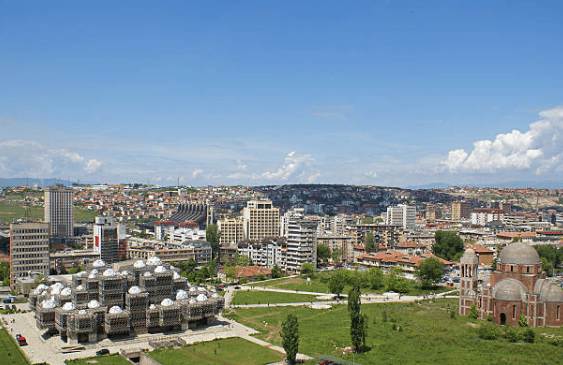
However, Kosovo has a connection with our beloved Indonesia. Indonesia was one of the first countries to recognize Kosovo’s independence. Besides this, Kosovo shares similarities with Indonesia: both countries have Muslim-majority populations. Approximately 95 percent of Kosovo’s citizens are Muslim, making it the largest Muslim-majority country in Europe.
These two reasons inspired me to visit Kosovo—specifically, Pristina, the capital. I traveled from Sarajevo, Bosnia-Herzegovina, by bus to Pristina. Initially, I wanted to go directly to Kosovo, but there was no direct bus route.
The journey had to pass through eastern Serbia. Fortunately, Serbia also grants visa-free access to Indonesian passport holders. I left at night, reaching the Bosnia-Herzegovina and Serbia border past midnight. Interestingly, passengers didn’t have to disembark.
At the checkpoint, an immigration officer boarded the bus, collected everyone’s passports, took them for inspection, and returned them promptly, allowing the bus to continue. Crossing the Serbia-Kosovo border didn’t require a passport check either.
Early in the morning, the bus arrived in Pristina. It turned out that Serbia still regards Kosovo as part of its territory, which explains the lack of a passport inspection at the border. When I arrived at Pristina’s bus terminal, it was still chilly. I waited inside the terminal to warm up and watch the sunrise.
Checking Google Maps, I found that my booked accommodation was a fair distance from the terminal, located in the heart of the old town. I decided to walk—partly as exercise and partly to experience the morning atmosphere of Pristina. By the time I left the terminal, the sun was shining. My Kosovo trip had officially begun!
In front of the terminal, several taxi drivers offered their services, reminding me of the atmosphere in Indonesia. I just shook my head, smiled, and continued walking. Walking was enjoyable, with sidewalks everywhere and light traffic.
After about 45 minutes, I arrived in Pristina’s old town. It took a bit longer since I stopped a few times to catch my breath and enjoy the sights along the way. Pristina isn’t a bustling or large city; it feels quite calm and again reminded me of Turkey.
Turkish Ottoman-style mosques can be seen everywhere, and some people even resemble Turks. This isn’t surprising since, like Bosnia-Herzegovina, Kosovo was once part of the Ottoman Empire, and there are many Ottoman remnants, especially in the old town area, the city’s center.
The center of Pristina is marked by a wide boulevard, about a kilometer long, with barriers preventing vehicles from entering. Both sides of the boulevard are lined with buildings, and my hostel was on one side.
Reaching my fourth-floor hostel, I was a bit tired. Fortunately, it was very comfortable and clean, with a balcony overlooking Pristina’s cityscape and a shared kitchen. I immediately made tea for breakfast and prepared lunch. Until the evening, I just relaxed in the hostel, enjoying the view.
Tourist Attractions in Pristina
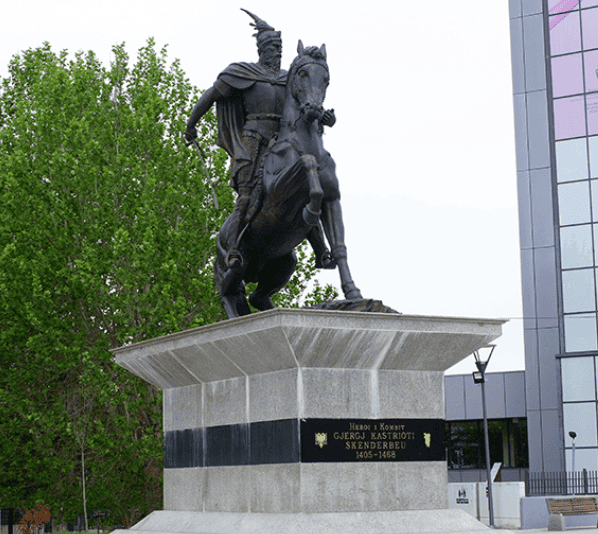
In the evening, when the sunlight had softened, I left the hostel to explore Pristina, though only around the boulevard. People were starting to gather, sitting on benches along the boulevard or hanging out in cafes.
Around the boulevard, you can see some interesting spots, especially historical statues. There’s a statue of Mother Teresa, which is why the boulevard is called Mother Teresa Boulevard. Mother Teresa is significant in Kosovo because her father was of Kosovar descent.
Not far from the small statue of Mother Teresa stands the imposing statue of Skanderbeg on horseback, reminiscent of the Sultan Hasanuddin statue at Sultan Hasanuddin Airport in Makassar. The Skanderbeg statue is located in Pristina Square. This monument honors the Albanian general Skanderbeg, who led Albania’s liberation from the Ottoman Empire in the 15th century.
Skanderbeg, an Albanian noble born on May 4, 1405, became the ruler of Kruje, a region in Albania, and united the country’s rulers. Before Yugoslavia’s era, Kosovo was once part of Albania. Besides Pristina, a monument of Skanderbeg can also be found in Tirana, Albania.
In front of the Skanderbeg statue, a fountain lights up as evening falls, attracting many boulevard visitors. I relaxed in front of the fountain, waiting for the night to settle in.
However, I didn’t stay out until late, as the temperature was dropping. I returned to the hostel and relaxed in the common room. Suddenly, I heard the call to prayer echoing from all directions, just like in Istanbul, Turkey, and reminiscent of Indonesia.
Second Day in Pristina
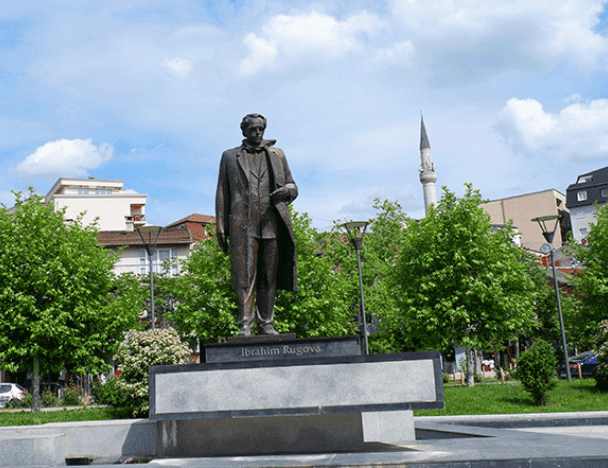
On the second day, I started my exploration of Pristina from Mother Teresa Boulevard. Besides the statues of Mother Teresa and Skanderbeg, another monument on Mother Teresa Boulevard is the statue of Ibrahim Rugova, located at the boulevard’s end.
Ibrahim Rugova, who initiated Kosovo’s separation from Serbia, served as the first president of Kosovo from 1992 to 2000, then again from 2002 until his death in 2006. He is honored as a national hero and regarded as the founding father of Kosovo.
Across the boulevard stands one of Pristina’s major mosques, Xhamia E Carsishe or the Bazaar Mosque. Known also as the Stone Mosque, it is said to be the oldest building in Pristina and marks the beginning of the old town. The Carshi Mosque was built to commemorate the Ottoman victory in the Battle of Kosovo in 1389.
The building resembles Turkish mosques. I passed by this mosque, as its door was closed and it wasn’t prayer time. Other tourists simply passed by as well. I continued to the Kosovo Museum next door. The museum was established in 1949, though the building itself, featuring Austro-Hungarian architecture, was built in 1889.
This is the largest museum in Kosovo. Even so, visitors don’t need to pay an entrance fee. I climbed to the second floor and found an intriguing collection. I spent about an hour in the museum before continuing my exploration.
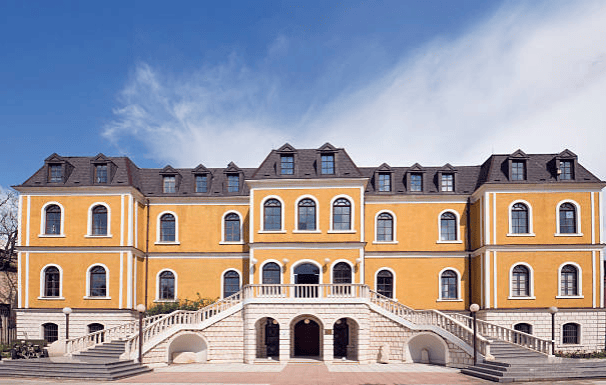
Once again, at another corner near the museum, I found a Turkish-style mosque. The Jashar Pasha Mosque, located in Pristina’s historic center, is a significant part of the Ottoman cultural heritage in this Balkan region.
The mosque is named after Jashar Mehmet Pasha, a wealthy Pristina resident who was also the mayor of Skopje in 1842. An inscription inside indicates that the mosque was built in 1834.
Since it wasn’t prayer time, this mosque was also closed. I continued along Pristina’s main road toward my next destination, Xhamia e Llapit, or the Llap Mosque. It’s a fair distance from the city center, located at the end of the main road. However, it’s still within walking distance.
When I arrived, the call to prayer had just begun, and many locals were gathering for the noon prayer. I performed ablutions at a nearby fountain, similar to those in Istanbul, before entering the mosque. This mosque is relatively small, about the size of a prayer hall, with a very simple interior.
However, it’s one of Pristina’s oldest religious buildings, constructed in 1470 during the Ottoman Empire. Believed to be built by Ramadhan Pasha, it was originally named Xhamia Ramadanije. Due to the large number of villagers from Llap who prayed there, it became known as Xhamia e Llapit. Today, it’s recognized as a historic monument in Kosovo.
After prayer, a few people greeted me, even though they didn’t speak English. They left one by one, and soon the mosque was empty. I left as well, heading back to the city center as the sun grew hotter.
Before reaching the Kosovo Museum, I turned left past the Jashar Pasha Mosque. My goal was to visit another mosque built during the Ottoman period, the Imperial Mosque, also known as the Ottoman Mosque, located not far from the Jashar Pasha Mosque. This mosque is larger than the three I visited previously.
A group of locals was chatting near the mosque, appearing to be elders. When they saw me, one asked if I was Muslim. Though he spoke the local language, I understood the gist. After I confirmed, they invited me in.

The mosque was built in 1461 by Sultan Mehmet II, also known as Muhammad al-Fatih, the sultan who conquered Constantinople. The exterior is simple, but the interior is more beautiful, with mosaics on the walls and hanging lamps reminiscent of those in Turkey. I didn’t stay long.
Meeting a Girl from Kosovo
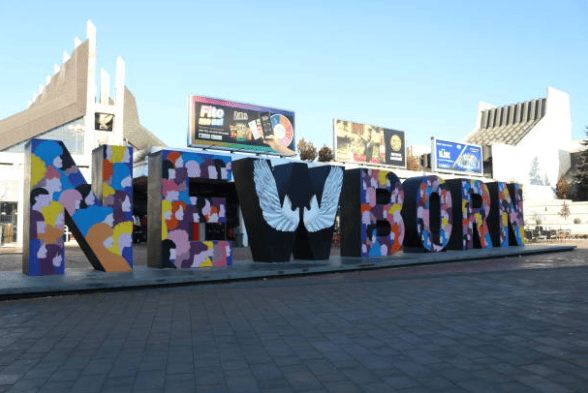
I continued toward the New Born Monument, now an iconic landmark of Pristina. Located in front of the Youth and Sports Palace, the monument was first unveiled on February 17, 2008, the day Kosovo declared independence from Serbia. It’s repainted with a different design each year.
Behind the monument, there are many shops and cafes where teenagers were hanging out when I arrived. While taking photos, some young people approached me, asking for their picture. I took their photos. Later, one of them, named Mustafa, introduced himself. Perhaps they thought I was a photographer. As I prepared to leave, Mustafa’s female friends handed me a tip.
They gave me 2 Euros. I declined, but they insisted. I found it amusing and wanted to laugh, but I didn’t want to seem disrespectful. So I accepted and thanked them, then returned to Mother Teresa Boulevard.
I went back to the fountain in the middle of the boulevard and relaxed, watching the scene in front of the Benneton Commercial Center. The building, formerly the Union Hotel, is now a business hub with Austro-Hungarian-style architecture. Inside, there are clothing stores, cafes, and restaurants.
Shopping in Pristina is relatively cheap compared to Western Europe. Occasionally, I bought snacks from the supermarket since they were inexpensive. Since they use Euros, I didn’t need to exchange currency. Before leaving Pristina, I bought some bread for the journey.
Leaving Pristina
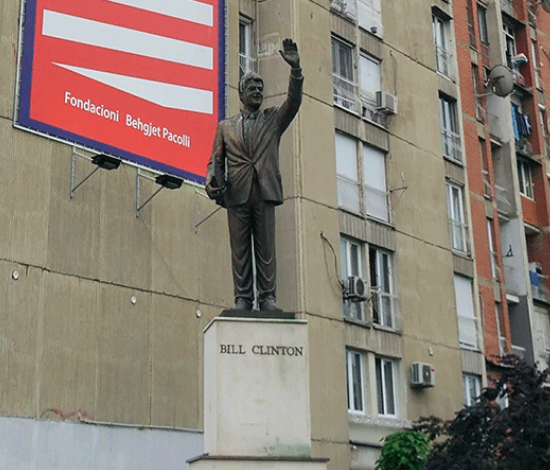
On the third day, I left Pristina. I walked from my hostel to the terminal, partly to see the Cathedral of Saint Mother Teresa and Bill Clinton Corner, which are along the route to Pristina’s bus terminal.
The Cathedral of Saint Mother Teresa is on the corner after turning onto Bill Clinton Boulevard. It’s a relatively new building, built in 2007 and dedicated to Mother Teresa. I only took a brief look since it was drizzling.
A few hundred meters from the cathedral, I reached Bill Clinton Corner. The statue of President Bill Clinton stands on the street corner, honoring his contributions to Kosovo’s independence. A large image of Bill Clinton is also displayed on the tall building behind the statue.
Holding an umbrella, I took a few photos before continuing to the bus terminal. At the terminal, I bought a ticket to Skopje, North Macedonia. Instead of a bus, it was a minivan with a capacity of fewer than ten passengers. After a short wait, I was on my way to Skopje.
